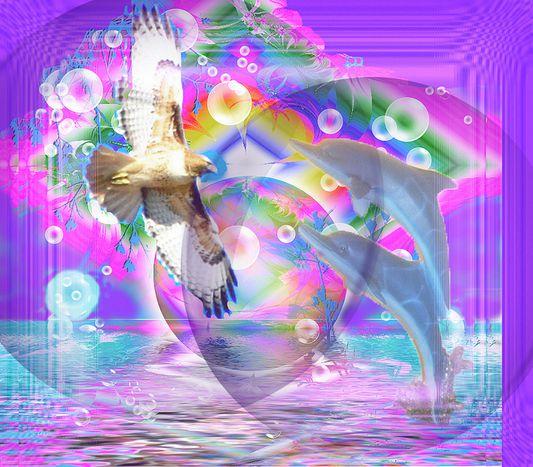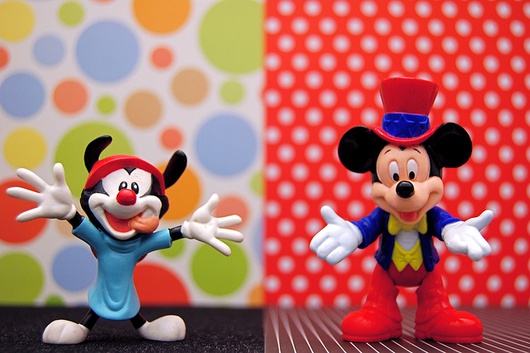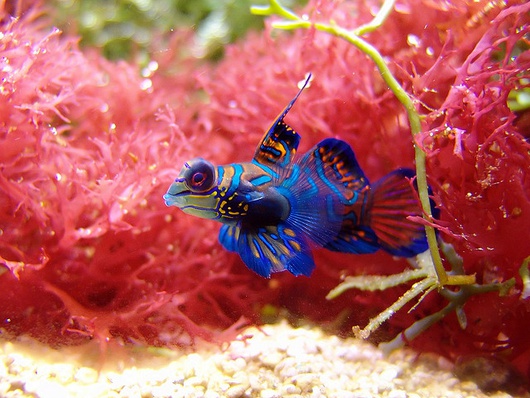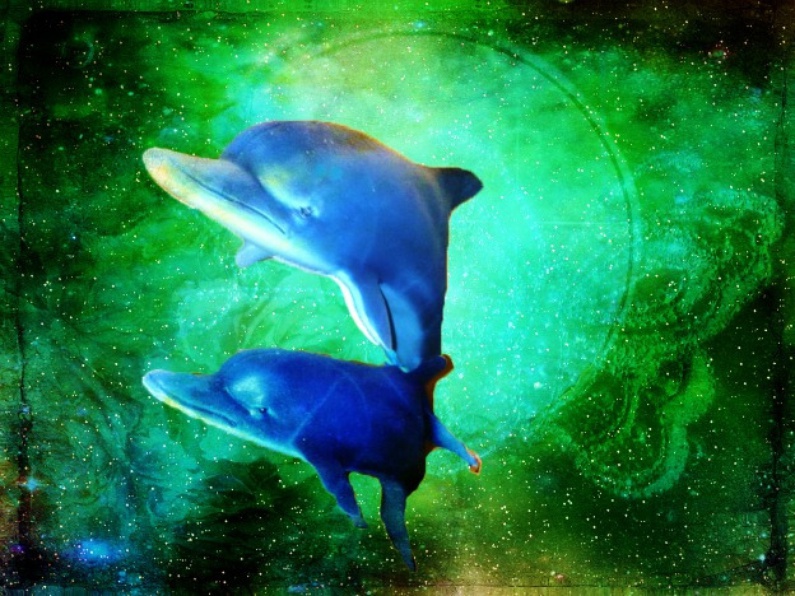
Dolphins on drugs: What can animals tell us about getting high?
Published on
A lot of us do it. A lot of us don’t. Our governments try their best to present them as the route to all evil while Baudelaire and Lil Wayne have sung their praises. Over the years the drug debate has been exhausted by parliaments and piss-heads alike, but how can animals shed new light on an age-old issue? Commentary from Olivia Capadose.
I turned to animals after watching the recent BBC footage of dolphins getting high. The documentary Spy in the Pod filmed a group of young male dolphins politely passing round a puffer-fish to “puff” on before all becoming half-eyed and floating vertically in bliss. Apparently, the dolphins have learnt that when intimidated, a puffer-fish releases a toxin, which in small doses induces a narcotic effect. This ridiculous scene inspired a search for other wasted animals and after exhausting YouTube’s gems including 'cats going crazy for catnip' and 'jaguars on DMT', it struck me – does this mean it is natural for living creatures to change their states of mind? And could these animals’ recreational drug habits be a valid argument against the demonization of human drug users?
Dolphins getting high in the BBC documentary "Spy in the Pod" (2014).
Motivated by my musings, I contacted Bruce Alexander – a drug psychologist and professor who in the 70s carried out an unusual study into opiate addiction called Rat Park. At the time, previous studies had examined animals such as rats and monkeys kept exclusively in uncomfortable cages. The results always showed animals quickly becoming dependent on drugs, which supported the common assumption that drugs cause immediate and irreversible addiction. But Bruce challenged this article of faith by housing half his rats in conventional cages and the other half in Rat Park – a 200 square feet rat heaven fitted with toys, painted backdrops of natural landscapes and the opportunity to procreate. Both groups were given the choice between pure water and morphine-spiked water drips, but the rat park residents consumed significantly less morphine. Try as he might, Bruce could not make addicts of his Rat Park residents — even after being force-fed morphine water for two months, rats in Rat Park always went back to the unadulterated water.
"As if the rats were having a party"
 Bruce’s findings not only rejected the common belief that exposure to drugs causes inevitable addiction but it also suggested that addiction is a product of social and environmental factors - just like people, it was the rats that were isolated, uncomfortable and unprotected that suffered from addiction. “What we also saw,” says Bruce, “is that although the rats in Rat Park didn’t administer as regularly as the caged rats, they did occasionally dabble.” Patterns of drug use among the rats were similar to patterns among humans. Some of the rats weren’t bothered while others took morphine from time to time – “as if they were having a party.” Bruce’s rats suggested the desire to take drugs recreationally is natural and possibly even good for us – as a means of enabling lateral thinking. He planned to do more careful analysis of this apparent recreational drug use. Would adolescent rats be more likely to experiment than older rats? Did they take the drugs in groups? There are several interesting but sadly unanswered questions here.
Bruce’s findings not only rejected the common belief that exposure to drugs causes inevitable addiction but it also suggested that addiction is a product of social and environmental factors - just like people, it was the rats that were isolated, uncomfortable and unprotected that suffered from addiction. “What we also saw,” says Bruce, “is that although the rats in Rat Park didn’t administer as regularly as the caged rats, they did occasionally dabble.” Patterns of drug use among the rats were similar to patterns among humans. Some of the rats weren’t bothered while others took morphine from time to time – “as if they were having a party.” Bruce’s rats suggested the desire to take drugs recreationally is natural and possibly even good for us – as a means of enabling lateral thinking. He planned to do more careful analysis of this apparent recreational drug use. Would adolescent rats be more likely to experiment than older rats? Did they take the drugs in groups? There are several interesting but sadly unanswered questions here.
 Bruce’s study coincided with the inception of Richard Nixon’s War on Drugs and the unpopularity of his report was reflected in the study being shut down. According to the Canadian Council of Animal Care, the trial rooms were insufficiently ventilated and despite Bruce pointing out that rats usually live in sewers and very enclosed spaces, the whole thing came to a halt. The fact that the same rooms were later used as a student counselling space without any work being done to the “ventilation issue” is a bit confusing. Bruce is careful not to indulge in conspiracies, but either students require less air than rats or someone wasn’t happy with Bruce’s agenda. As it goes, Rat Park made little impact, quickly becoming buried by government studies and billion dollar anti-drug organisations such as the National Institute of Drug Abuse.
Bruce’s study coincided with the inception of Richard Nixon’s War on Drugs and the unpopularity of his report was reflected in the study being shut down. According to the Canadian Council of Animal Care, the trial rooms were insufficiently ventilated and despite Bruce pointing out that rats usually live in sewers and very enclosed spaces, the whole thing came to a halt. The fact that the same rooms were later used as a student counselling space without any work being done to the “ventilation issue” is a bit confusing. Bruce is careful not to indulge in conspiracies, but either students require less air than rats or someone wasn’t happy with Bruce’s agenda. As it goes, Rat Park made little impact, quickly becoming buried by government studies and billion dollar anti-drug organisations such as the National Institute of Drug Abuse.
"Humans don't have the innoncence of dolphins"
The government had the last say, but what does Bruce think – does animal drug use mean it is natural for humans to take drugs too? “Yes and no. We can certainly say that drug use is natural in the animal kingdom because evolution produces a correspondence between what feels good and what is good for us. Humans in their natural form also know what’s good for them because evolution tells us, but now in the 20th century, there are so many drugs we know very little about. Modernity has short-circuited our cleverness; therefore we cannot make an argument for taking what we like. We don’t have the innocence of dolphins living in dolphin paradise.” Come to think of it, you don’t see dolphins with a "ten puffer-fish a day" habit or reindeers running drug cartels across the wilderness. Animals don’t seem to have the same addiction problem that we do. “Addiction,” Bruce says, “is always the product of the breakdown of community, either as a consequence of historical shifts that come with modernity or individual problems such as a flood.”
 When we look to tribal communities untouched by colonialism that use drugs as part of spiritual or social rituals, addiction is non-existent. It is only after these communities are broken that addiction becomes epidemic. “Community is a fragile flower”, Bruce explains. “Addiction has become a major issue because of an intrinsic breakdown of community, modern hyper-capitalism and all that stuff.” Having been catapulted into modernity, we humans are not as clever as we think. Our relationship with drugs is still a mystery, but taking drugs is not a modern phenomenon. The desire to take drugs is a natural one – as Bruce’s rats proved. Those furry creatures can teach us that the choice to take drugs should not be subject to entitled slander and that the people who sadly become addicted are the result of broken communities rather than flawed characters.
When we look to tribal communities untouched by colonialism that use drugs as part of spiritual or social rituals, addiction is non-existent. It is only after these communities are broken that addiction becomes epidemic. “Community is a fragile flower”, Bruce explains. “Addiction has become a major issue because of an intrinsic breakdown of community, modern hyper-capitalism and all that stuff.” Having been catapulted into modernity, we humans are not as clever as we think. Our relationship with drugs is still a mystery, but taking drugs is not a modern phenomenon. The desire to take drugs is a natural one – as Bruce’s rats proved. Those furry creatures can teach us that the choice to take drugs should not be subject to entitled slander and that the people who sadly become addicted are the result of broken communities rather than flawed characters.



